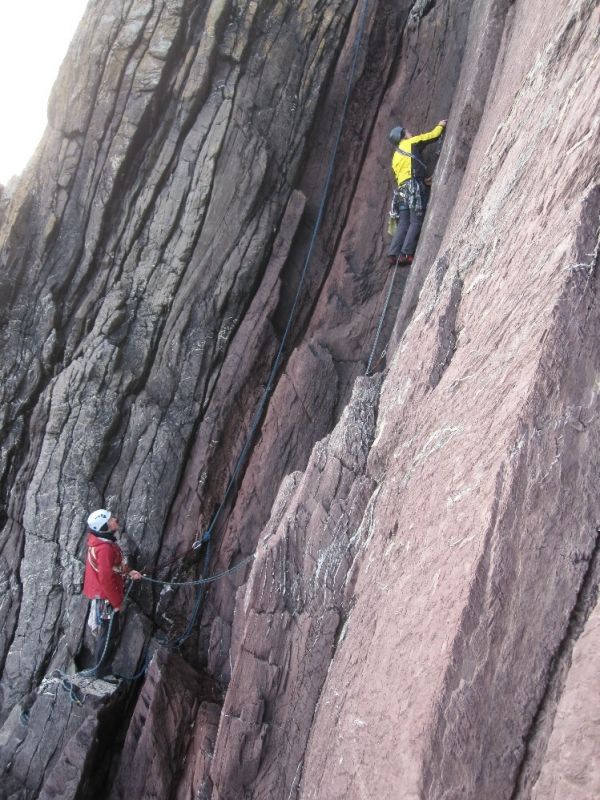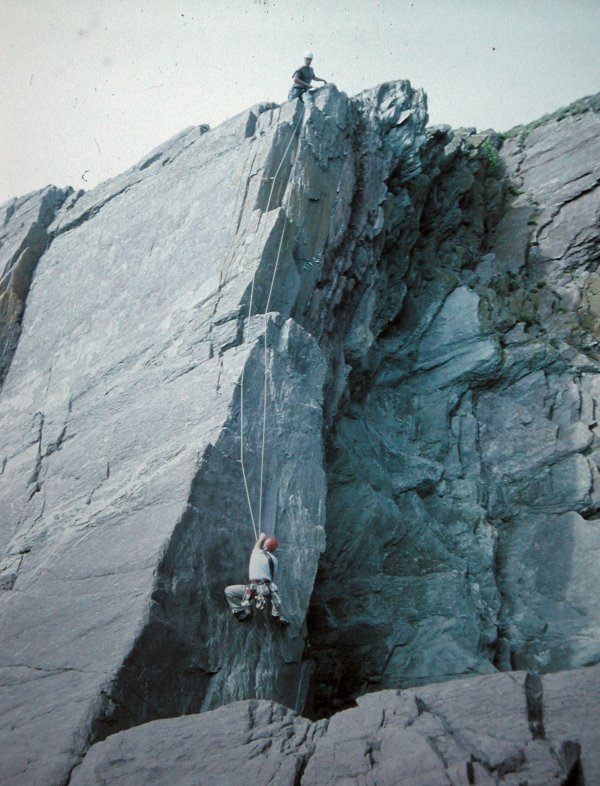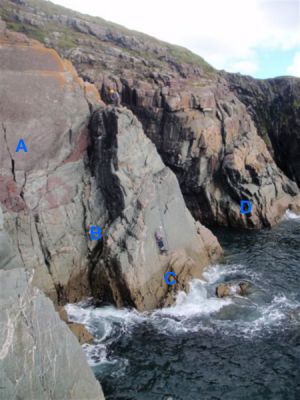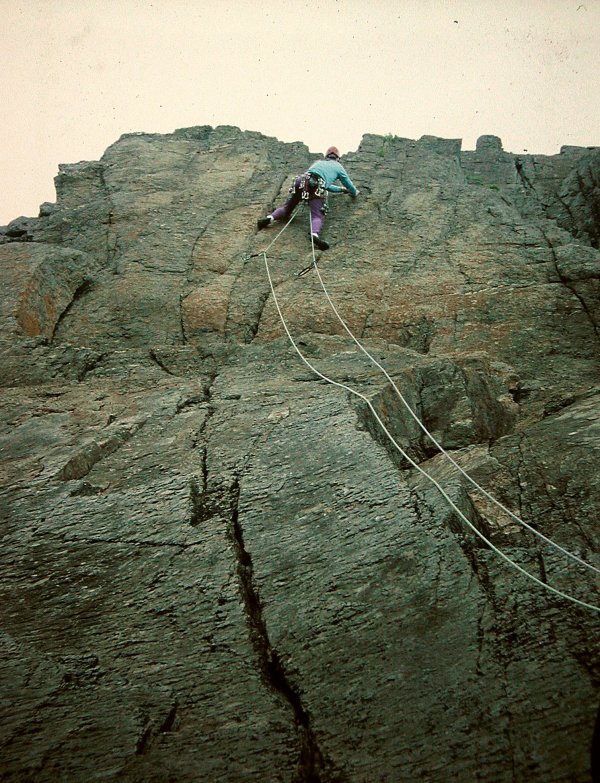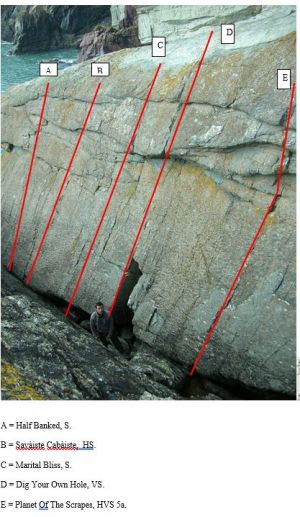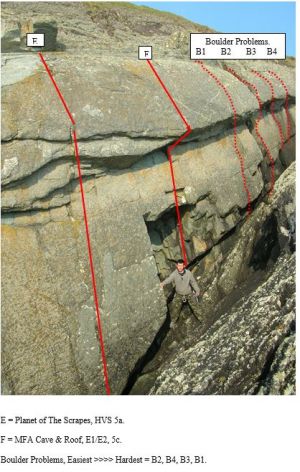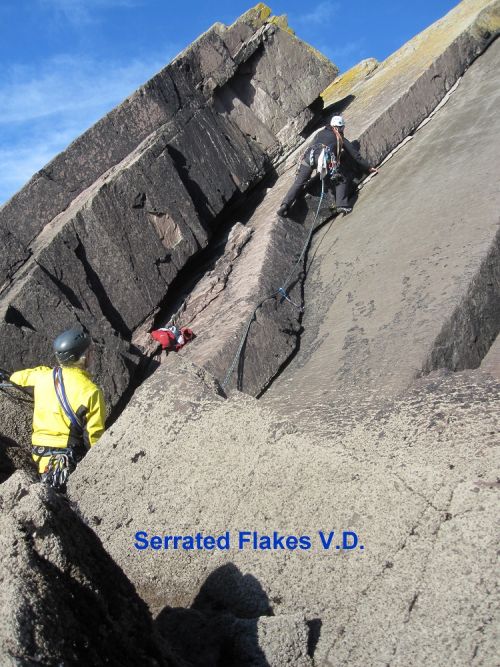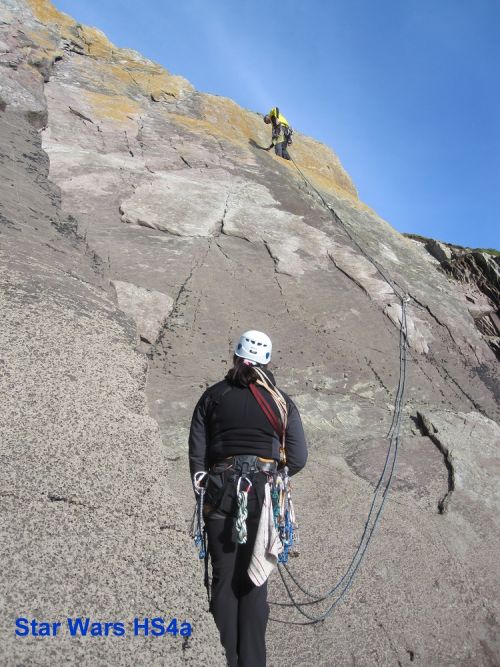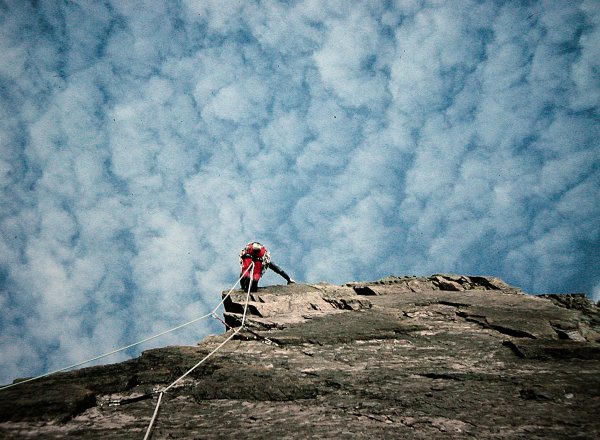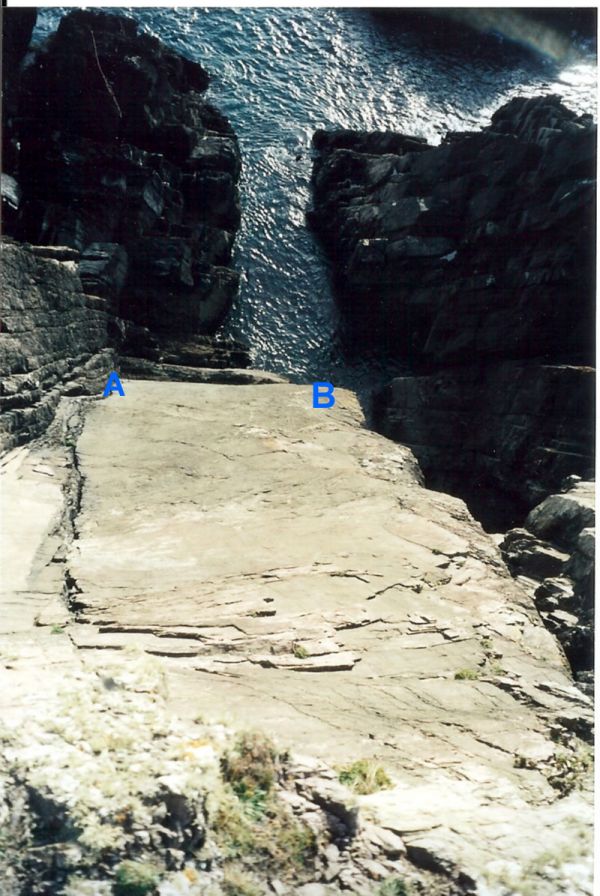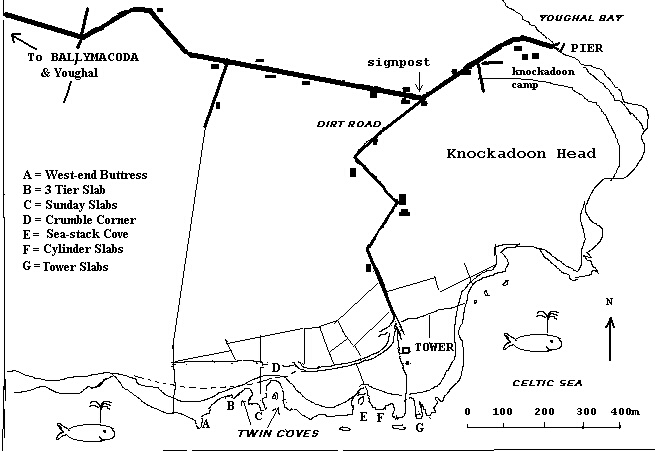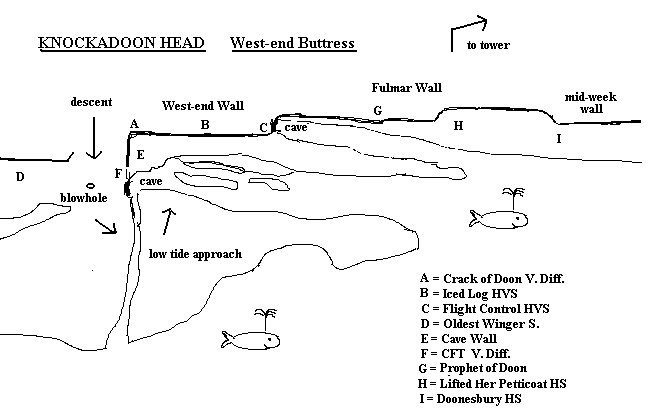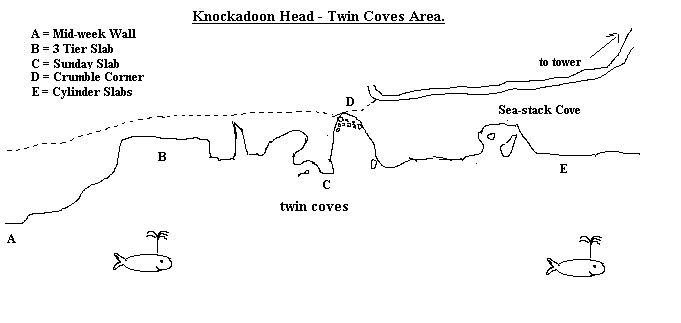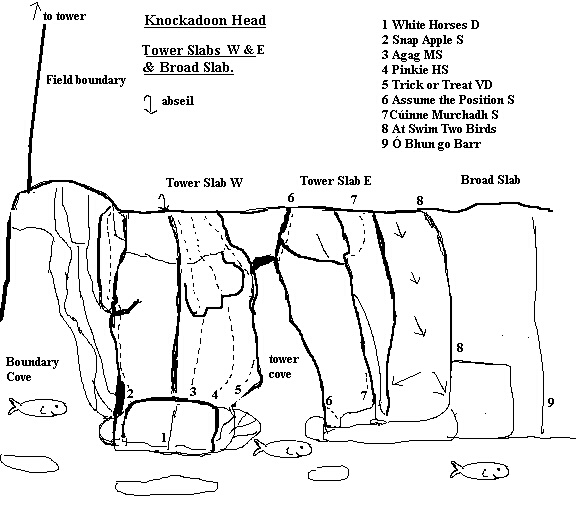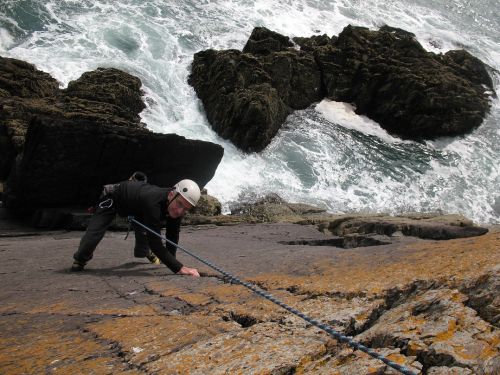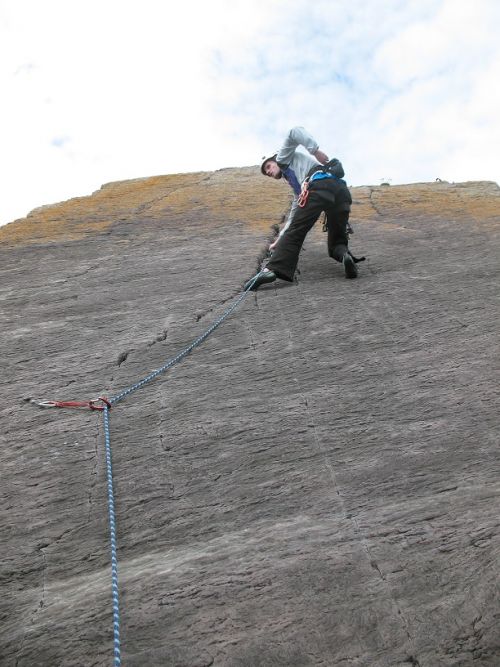Knockadoon Head
Introduction
Grid Ref X 089 695, OS Map 81 Discovery Series, is the western tip of Youghal Bay, and lies 8 km south of Youghal town as the crow flies. The rock is categorized as Gyleen Formation - sandstone, with mudstone and siltstone and, in general, is sound, with good friction and good gear placements. As with all sea-cliffs, the more open the rock is to the scouring power of the waves, the cleaner and sounder it is. The main type of climbing on offer is on slabs, with the occasional steep wall thrown in for good measure.
Approach. Leave the Youghal/Cork road a little west of Youghal, signpost for Gortroe, and head for the village of Ballymacoda. Follow the road through the village towards Knockadoon Pier (which is where the road ends). At a distance of less than 500m from the pier (signpost for Knockadoon Dominican Youth Camp) take a dirt road on the right . Follow the laneway to where it ends at a car park right of and before an old tower. Going through the gate you will see a newer watch hut and a stone EIRE sign on the ground. There is now a good walking path along the cliff top called the Capel Head Trail although once leaving this the approaches can be rougher underfoot.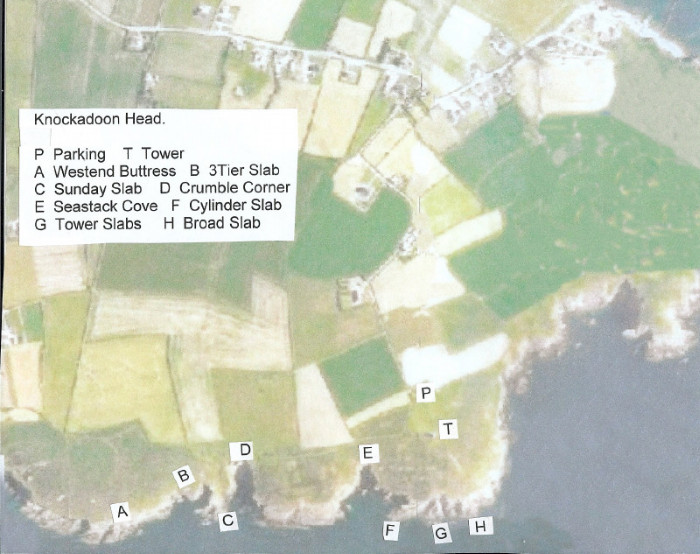
The climbing areas, and the climbs within each area, are described from west to east (left to right, facing in).
There are still a number of areas untouched.
West End Buttress
This marks the western limits of the climbing area, approx. 500m westof the tower (about 6 - 8 minutes walk).
Approach. Take the rough cart-track on the right of the entrance to the tower field, ignoring a turn to the right. Just before the track ends in a field leave it at a right-hand bend and follow the narrow path parallel to the coast, passing some tottering pillars (Crumble Corner) at the back of a cove. The path deteriorates as it crosses a rough hollow but improves as it rises again. After about another 150m, at the path's highest point, leave it and go down sharp left towards a small headland containing a large cave. At half to low-tide scramble down over the cave and traverse back east(right facing in) to the foot of the climbs. At full-tide abseil down the corner of Crack of Doon.
Cave Wall
The Oldest Winger. 10m S
G. Moss, S. O Hanlon, F. Kenny. 16/08/03
Start 4m west (left) of the cave exit, directly below a small overhang with good undercuts. Climb to the overhang and, using a thin quartz vein above, move left to a flake then back right above the overhang. Move up to a belay.
C.F.T. 15m D
S. O Hanlon, F. Kenny, G. Moss 16/08/03
Traverses the cave from east to West Half-to-low tide. An atmospheric outing on a windy day. Start at the mouth of the cave. Chimney up and out through the back of the cave.
The following four climbs take the cracks in the wall above right of the cave entrance and leftof the main face.
Exit Left 14m. HS 4b
G. Moss, P. Britton 16/08/03
An abortive attempt to climb the twin parallel cracks immediately right of the left edge. Climb to a small foothold below the final steepening. Move out left and up to finish. A direct finish would be more fitting, though harder.
Variation VS 4c Direct finish.
Fran the Man. 15m S
F. Kenny , S. O Hanlon 16/08/03
The deep cracks to the right of above.
Dungarvan 14m S
D. Broderick, S. O Hanlon, F. Kenny. 16/08/03
The red cracks just right of Fran.
Crack of Doon 16m S
G. Moss, P. Britton, 16/08/03
The crack in the corner between Cave Wall and West End Wall.
West End Wall.
The wall at right-angles to Cave Wall Cracks.
Up and Doon. 17 m HVS 5a
G. Moss L. Convery 26/5/04
The thin crack just right of Crack of Doon and left of the inverted v-notch gives good, fingery climbing.
No Toll, 17m VS 4c
C. Ennis, J. Kinsella, 16/08/03
Start about 3m right of Crack of Doon. An inverted v-notch leads to a vertical crack on it's right, which is gained by bridging moves. Sustained climbing.
Iced Log 20m HVS 5a
P. Britton, D. Broderick, 16/08/03
The thin finger crack in the right facing corner that runs up the centre of the wall.
Gold n Topsy. 22m HS (Now HVS 5a)
P. Britton, G. Moss, 16/08/03
Start 3m left of the right end of the wall. Climb the crack then traverse rightwards and climb the face near the outside corner. Finish up the top 3m vertical crack.
(Notes of 22 Jul 2010 by P.Britton: This climb is now harder following the loss of some rock off the outside corner below the upper crack. The grade is now HVS 5a)
Flight Control 20m HVS 5a
P. Britton, D. Broderick, 16/08/03
Start just right of and around from the main wall, at a rock runway left of the narrow cave. Climb a 4m rightward trending sharp crack up the face of a white pillar. Move left above the crack then back right to mantelshelf the top of the pillar. Climb more easily from here to the top, finding protection in the exit crack of Gold n Topsy.
Fulmar Wall
Approach as for West-end Buttress as far as the rough hollow. Continue along the path for a short distance, then scramble down gentle slabs and ledges just west of Three Tier Slab (see below), and traverse around west to the foot of the wall, right of the narrow cave mentioned above. It is also possible, at low tide, to approach this area from the foot of West-end Buttress, by hopping across the channel at the mouth of the narrow cave.
Note. As the ledges on this wall provide nesting sites for fulmars during May, June and July, it should be avoided during these months.
Topsail S
L. Convery, G.Moss 6/11/04
Start about 5m right of the narrow cave, on a good ledge above the high-water mark, below a right-facing, overhanging corner on the left side of the slab above the wall. Climb up over ledges to the foot of the corner. Move up this on flakes and climb the slab via the corner crack, laybacking or bridging as preferred. Good protection.
Prophet of Doon. 35m. VS 4C
G. Moss L. Convery 27/3/04
Varied climbing, with a well protected crux. Start about 10m right of Flight Control and the narrow cave, on a good ledge above the high-water mark and directly below a 3m flake that forms a right-facing crack near the top of the wall. Climb easily to the crack and up this to the top of the flake. Make a difficult mantelshelf onto the horizontal crack above (crux) A delicate step up onto the slab is followed by a short, delicate traverse right to gain a thin crack. Follow this (small wires), to the top.
Lifted Her Petticoat. 25m. HS
L.Convery. G.Moss 23/9/03
Start 20m right of Narrow Cave and 5m left of the left-hand end of Mid-week Wall, below a series of flakes leading up left into an overhanging, right-facing corner. Climb easily to the corner, move up, then, (this is the easy and slow bit) make a delicate rising traverse up right using undercuts . Belay well back.
Mid-week Wall
About 25m east of the narrow cave there is a grey, bulging wall, with some white quartzite streaks and four parallel, vertical cracks. Approach as for Fulmar Wall.
Doonesbury. 20m. HS
G. Moss L. Convery 23/9/03
Start near the left end of the wall, below a thin crack that runs up to a short left facing corner/crack about 3m above. A couple of thin moves lead to a good hold and a mantelshelf below the corner. Climb the corner and move up slightly left to a higher, shallow, left facing corner with a thin crack. Up this to finish.
People Before Prophet. HVS 5a
G. Moss L. Convery 28/8/04
Hand-jamming on perfect rock, friends useful. Start about 5m right of Doonesbury, below the widest of the cracks. Climb the crack.
In Memory of Seals HVS 5b
C. Ennis. J. Kinsella. P. Britton 8/11/04
Takes the short vertical crack to the right of People Before Prophet. Some thin moves after a difficult finger jam at mid-height are followed by better holds and a relieving finish.
Sore Fingers 10m HVS 5a
F. Adam, C. O Donovan, 7/8/2005.
Start 2m right of People Before Prophet and climb the obvious small crack. A succession of fairly painful finger jams eventually get you up and out of trouble. A couple of small friends and wire nuts help a lot.
3 Tier Slab
About 30m east (right) of Mid-week Wall, and just west of Twin Coves, there is a steep wall capped by three bands of curved slabs. Approach as for West-end Buttress. Follow the path past Crumble Corner and the hollow and go down left until above the slabs. It is possible to scramble down on either side of the slabs.
Sinister Crack. 18m. D
L. Convery G. Moss 23/9/03
Climb the crack running up the left side of the slab.
A. Never on a Sunday. 18m VS 5a
G. Moss L. Convery 23/9/03
Climb the thin central crack.
B. Redshanks. 15m. D
L. Convery G. Moss 25/10/03
Climb the curving cracks on the left-facing wall.
C. Choughed. 15m. S
G. Moss L. Convery 23/9/03
Immediately right of Three Tier Slab is a steep slab capped by a small triangular shaped wall. Start on a ledge at high-water mark below the centre of the slab. Climb on small holds to a good ledge. Continue up the face on generous holds.
3 Tier Slab A - Never on a Sunday. B - Redshanks. C - Choughed. D = Escape from Hades.
Christian Brother?. 12m. D
L. Convery G. Moss 23/9/03
Start 2m right of Choughed. Move right and climb diagonally right to the top.
D. Escape from Hades 15m. S.
J. Reville, G. Moss Aug. 2010.
This climb takes the narrow chimney on the L side of the buttress immediately R of 3 Tier Slab.
Abseil to the foot of the chimney. Climb the chimney and move left onto the slab. Continue up over the overlap to a block belay.
Sunday Slab
At the tip of the promontory dividing the Twin Coves. Approach as for West-end buttress. Shortly after passing the tottering pillars (Crumble Corner) go down the headland between the two coves to the top of a fine little slab above the sea. This is Sunday Slab. The slab has a large block at it's base and a crack running up it's center.
The first route is about 10m to the west (left facing in) of this slab and takes a crackline up the center of an orange slab which is undercut at the base.
On Yer Bike. 14m S
S. O Hanlon, F. Kenny, G. Moss. 17/08/03
Start at the high-water mark below the crack. Move up and climb the crack which is hard to start.
Black Ramp Crack. 13m HS 4a
F. Kenny, S. O Hanlon, G. Moss. 17/08/03
Start at the block at the foot of Sunday Slab. Climb to the shoulder near the bottom of the left edge of the slab and step around and down left to gain the narrow black ramp. Climb this, using the crack above and the edge of the slab, to where the ramp narrows. Move around left then pull up to gain the top of the slab.
The following three routes climb Sunday Slab.
Port. 10m VD
G. Moss, S. O Hanlon, F. Kenny. 17/08/03
The left edge.
Mid-Ships 10m D.
G. Moss, S. O Hanlon, F. Kenny. 17/08/03
The fine center crack.
Starboard 10m D.
F. Kenny, S. O Hanlon, G. Moss. 17/08/03
The thin crack just inside the right edge.
Sea-Stack Cove
The cove to the east of Twin Coves easily identifiable by the sea-stack.
Approach. From a grassy hollow above the back of the cove scramble down carefully west (right facing out), over grass initially, to reach easy slabs and, finally, good ledges above the high water mark. Move back east on these until below a yellow corner with a continuous crack up the centre. This is the line of Triple Crown.
Allez France!. 13m VD
G. Moss L. Convery 28/3/04
Start beneath the corner crack. Climb diagonally left up a slab to the foot of a ramp sloping up right. Climb the ramp and exit left via a crack. Block belay 3m back.
Triple Crown. 13m S
L. Convery G. Moss 28/3/04
Start below the crack, which is climbed to the top. Belay as for Le Cocq.
Grand Slam. 14m S
G. Moss L. Convery 28/3/04
Start as for Triple Crown. Climb right-wards over a grey step and move up steeply over a second step. Move back left to finish just right of the top of Triple Crown.
Flat-topped Aiguille. 15m. VD
L. Convery G. Moss 27/3/04
This route follows the arete on the landward side of the sea-stack. Approach (low tide only) as far as the base of Triple Crown, then descend ledges and cross to the boulders at the foot of the arete. Gain the arete via a short chimney and follow it to the top. Descend by reversing the route.
Cylinder Cove
This area lies a little west of the Tower. From the Tower follow the field boundary running down towards the sea, to where it ends at the top of a cove ( Boundary Cove). Traverse west passing above another cove (Boulder Cove) and go down to where an obvious cylindrical band of rock caps a short, wide and steep slab. This is Cylinder Slab. or maybe Roly Poly Slab.
Cylinder Slab
A lot of activity has seen the creation of five new relatively short routes and some boulder problems on this sheltered slab of rock. It is close to the parking area/main tower; to get to it, heading straight down towards the sea, pass the tower and the small concrete lookout building. Follow the path down to where it peters out. Swing right. Over an old small earth bank/wall go left. The ground steepens. Veer downwards, right and voila, if you have not fallen off the cliff backing the cove, you will have wandered correctly onto the top of the Cylinder or Rolly Poly slab. The climbs are not readily discernable from above. The slab is faced by a smaller slab. These two combine to give an overall V shape. All the climbs start from where these two slabs meet.
All the climbs have been done on lead to verify the grade. See the photographs Topo 1 & Topo 2 above.
As you look at the slab. Starting on the far left and highest section:
Half Banked. S, 10m.
Alan O’ Shea & Kevin Ring, Summer 2006.
Two metres from LHS edge of the slab. Starting under the slightly broken-up overlap. From the bottom of the V (to squeeze out maximum climbing), easy and enjoyable moves on big crimps and edges to the overlap. Crux. Gear beneath overlap. Step up and over.
Savàiste Cabàiste. HS, 9m.
Alan O’ Shea & Kevin Ring, Summer 2006.
Thin crack two metres right of Half Banked. The grade is dictated by the sparse gear. Enjoyable climbing up the slab. Stepping over the small, multi-layered, overlap is the crux. Easier and more positive than it looks. No big jugs but all the grips are there.
Dig Your Own Hole. VS, 8m.
Alan O’ Shea & Kevin Ring, Summer 2006.
Start at/in the big obvious rectangular cut away cleft. Climb out of this and up to the overlap. The crack appears much more pleasant than it is. No points for guessing where the crux moves are. Sorting out gear for the following crux moves leaves one a little unsure. Once above scamper to the top.
Planet of the Scrapes. HVS 5a, 8m.
Kevin Ring, Summer 2006.
Right of Dig Your Own Hole, obvious crack through the overlap. Another fine crack with the inevitable crux at the overlap. Easy climbing to the overlap. Gear along the way, some “sweet” but not exactly sign posted. The obvious big cut out foothold can be comforting. Climbing through and above the overlap is somewhat strenuous and committing. White Quartz holds and a finger tip crack are the plat de jour on the crux. A long reach for a jug-hold from the climbing Gods. And then you are up. Shaking and laughing.
MFA Cave & Roof. E1/5b, 8m.
Terence J. Hoare Alan O’Shea, March 2007.
An obvious feature of the slab is the 2 metre wide, one metre deep cave. Essentially follow the right hand side crack through the cave roof and the overlap above this. Starting at the back of the cave, climb up through the roof and onto the small face above. Protectable but strenuous climbing. From this squatting position place the gear (possible nut and cam) to protect the step-up moves to the crux, which is climbing over and up from the next big overlap. Committing, pumpy and sustained, this is a gem of a climb with, if it is of any comfort, a bomber belay at the top.
The Rolly Poly Boulder Problems.
Further right there are four boulder problems, probably going at 4b up to 5a. They tackle the weaknesses in the overlap. Which at the middle-right end of the slab, sticks out about .5m and is no more than 2-3m high.
The 4b problem is the biggest crack with the big jugs and an arm-jam.
Flanking this problem on either side there are two other problems. These rely on quartz finger holds and stretchy step ups. Enjoyable tests of ones bouldering mettle.
The fourth is a bit of a highball problem. This problem lies about 2m left of the 4b problem (looking at it). More fingery stuff above the overlap. A long committing reach is required to reach the top and the subsequent respect.
The AK Traverse. This starts at the left end of the slab and works up to the overlap. Basically follow under the overlap rightwards all the way along. Dissecting each of the described climbs and problems. One for a quiet day with no one else around to get in your traversing way. Soloed by the AK-Stretchmasters (Alan O Shea & Kevin Ring) in that Indian summer of 2006.
Below Cylinder Slab there are four slabs. These are described from west to E, (left to right facing in).
A. Easy Slab. Below the west end of Cylinder Slab. An easy scramble down this short slab provides access to a ledge system (uncovered for fours hours either side of low tide) leading to the following two slabs.
B. Cleft Slab. The next slab to the right. (Easily identified by the half-meter wide cleft splitting the slab from top to bottom).
Serrated Flakes. VD
L. Convery G. Moss 15/6/03
Climbs the right facing corner to the left of the cleft, using a series of small flakes and the crack.
AOS Slab Route 6m VS
Terence Hoare
A gearless solo. Truly wonderful on tinies and friction at just the right angle, although it does steepen in the middle. A great route.
Cleft Right. S
G. Moss L. Convery 15/6/03
Climbs the right edge of the cleft. Poor protection.
Two gearless eliminate routes squeezed on to the blank slab between Cleft Right and W.M.D worth recording. (These may have been climbed before)
1.Moonwalk. (HS).
M Donnelly, April/2011
Start 1m right of 'Cleft right' on a large block at the base of the slab. Climb
delicately up the slab trending rightward after 2/3 height to a break. Finish up the slab above.
2.To boldly go (VS). Start below the block at its right end. Move delicately straight up the slab trending left at 2/3 height to a break. Finish up the slab above. P Kelly, April/2011
W.M.D. VS 4b
G. Moss L. Convery 15/6/03
Start below two thin parallel cracks near the right edge of the slab. Climb the right-hand crack then the left crack to where it ends. Delicate moves right gain the edge which is followed to a break. Climb the final section on small holds. Sparse protection.
W.M.D. Direct VS 4c
Climb to the end of the left hand crack and move directly and delicately upwards using two small quartz veins. finish as for above.
(This may have been done before, M. Donnelly April/11)
C. Starfish Slab. The next slab to the right.
Eureka. D.
L. Convery G. Moss15/6/03
Climb the right facing corner on the left edge of the slab.
The Milky Way. HS 4a
G. Moss M. Casey, J. Reville 6/11/10
Start as for Eureka, at the foot of the corner. Move up and traverse R along a narrow footledge to the centre of the slab. Climb straight up, following vague cracks, with widely spaced protection.
Star Wars. HS. 4a
G. Moss L. Convery 26/10/03
Start 2m right of the corner. Climb diagonally right to gain the right edge of the slab. Follow this over a slight bulge to a break and runner. Continue up the edge to finish.
D. Narrow Slab. The next slab to the right. Access is by abseil.
Thanks, Dave. D.
L. Convery G. Moss 15/6/03
The right facing corner on the left edge of the slab.
Tower Slabs
Tower Slab West
Follow the field boundary below the Tower to where it ends above a large cove (Boundary Cove). Tower Slab West is the slab immediately east of the cove (left facing out). Abseil down the centre of the slab to a ledge with a short wall behind it (about 23m).
The following four routes all start from this ledge.
Snap Apple. 30m S
G. Moss L. Convery 26/10/03
Climb diagonally left to gain a short black corner on the left edge of the slab.. From the top of the corner follow the edge over a small overhang to a stance. Step down left to gain the foot of a narrow subsidiary slab and climb this near it's left edge to a crack on the right. Pull over a block to finish.
Snap Apple
Agag. 25m. S
L. Convery G. Moss 26/10/03
Takes the thin crack about 1.5m right of the wide crack splitting the slab. Follow the crack to where it fades below a small overlap. Step up left to reach an edge (crux) and continue directly to the top.
Pinkie. 25m. HS
P.Britton, L. Convery G. Moss 25/10/03
Start 2m in from the right edge below a thin crack. Follow the crack delicately to the overlap. Surmount this (crux) and continue more easily to the top.
Trick or Treat. 25m. VD.
G. Moss L. Convery P.B. 25/10/03.
Start as for Pinkie. Climb diagonally right to the edge and follow this to the top. Poor protection.
The foot of the next route, which is on a lower, subsidiary slab, is reached by scrambling on down from the ledge at the foot of the main slab.
White Horses 10m. D.
L. Convery G. Moss 25/10/03
Climb the centre crack. Scramble off right.
Tower Slab East
From the top of Tower Slab west move east (left facing out), passing the head of a narrow inlet and scramble down over easy slabs, moving back west to the base of the long slab bordering the inlet.
A = Cúinne Murchadh. B = Assume The Position.
Assume the position. 25m S
G. Moss L. Convery 24/9/03
Start from a ledge at the bottom of the slab (half to low tide only). Climb left to gain the left edge and follow this, in an airy position, to where the inlet ends. Continue up the wide crack .
Cinne Murchadh. 25m. S
L. Convery G. Moss 24/9/03.
Start as for above. Climb the left facing corner to where the crack widens and the angle eases, at about 18m. Move up and right through a break in the wall on the right and climb the slab and corner to the top.
Broad Slab
The slab 15m east (left facing out) of Tower Slabs.
At Swim Two Birds. 25m. VS 4b.
G. Moss L. Convery 14/6/03
Climb the long diagonal crack on the right facing sidewall overlooking the left side of Broad Slab.
Full Moon Knockadoon. 30m. HVS 4c.
H. Gruber, J. Jam; August 2022
Between the seals and the dogs,
Crack and slab just left of the Mod,
The micros are in,
The flakes are quite thin,
If that’s a jug then thanks be to god.
Ó Bhun go Barr. 35m M
L. Convery G. Moss 14/6/03
The long crackline up the center of Broad Slab.
The following two climbs are further east, full details later.
Black Wall Chimney. 15m. S.
G. Moss L. Convery 14/6/03
Climb the chimney at the right hand end of Black Wall.
Slab & Overhang. 15m. VD
G. Moss L. Convery 14/6/03
To the right of Black Wall. Climb a slab to the foot of a short overhang on the right. Over this on good holds.
Topos by Gerry Moss
Topo 1: File:Knockadoon Topo1.pdf
Topo 2: File:Knockadoon Topo2.pdf
NOTE:
Knockadoon is a nice place to climb with easy access. The climbs however are rather short in places, especially the Sunday slabs which if were two or three times longer would be out of this world, and they are a lot easier than they appear. It does nicely for one day's climbing and you could climb at Ardmore the second day which is across the bay.
Tim O'Connell
